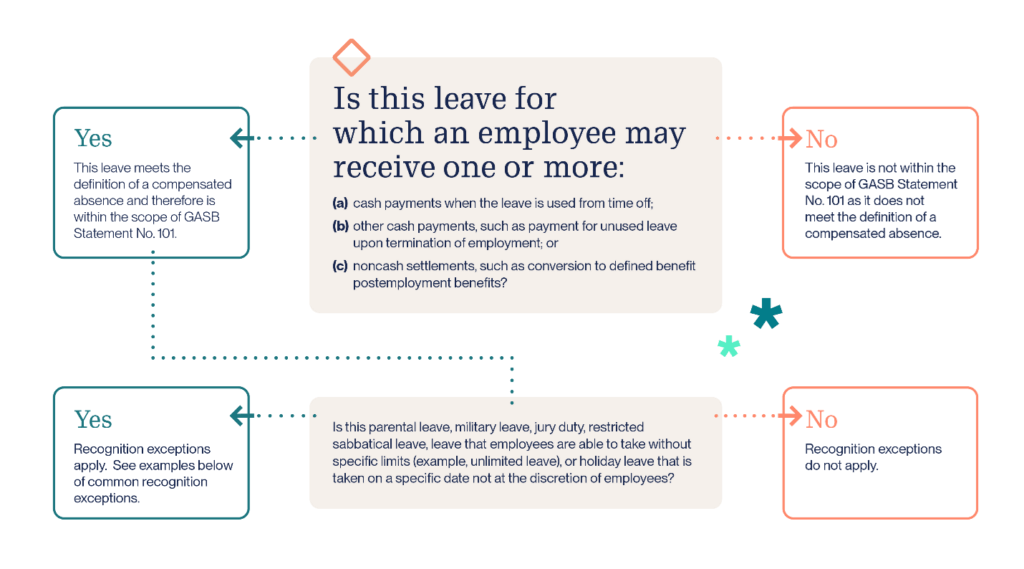Governmental Accounting Standards Board (GASB) Statement No. 101, Compensated Absences, updates accounting and financial reporting standards for compensated absences and associated salary-related payments including certain defined contribution pensions and other postemployment benefits (OPEB).
The standard defines a compensated absence as leave for which employees may receive one or more:
- Cash payments when the leave is used for time off.
- Other cash payments, such as payment for unused leave upon termination of employment.
- Noncash settlements, such as conversion to defined benefit postemployment benefits. The payment or settlement could occur during employment or upon termination of employment.
Compensated absences generally do not have a set payment schedule. Examples include vacation (or annual) leave, sick leave, paid time off (PTO), holidays, parental leave, bereavement leave, and certain types of sabbatical leave.
Recognition and Measurement
The appropriate recognition method depends on the entity’s reporting framework:
If financial statements are prepared using the economic resources measurement focus (government-wide/full accrual statements):
Liabilities for compensated absences that should be recognized include:
- Leave that has not been used.
- Leave that has been used but not yet paid or settled.
Applicable salary-related payments, obligations that a government incurs related to providing leave in exchange for services, should be included in the liability measurement. Examples of salary-related payments include the employer share of FICA and other employer payroll tax obligations. In contrast, salary-related payments to defined benefit pensions or OPEB should not be included in the measurement of the compensated absence liability.
If financial statements are prepared using the current financial resources measurement focus (governmental fund statements):
A liability for compensated absences should be accounted for and reported on a basis consistent with governmental fund accounting principles. Accordingly, a compensated absence would be accrued for the amount that normally would be liquidated with expendable available financial resources.
Disclosure
The statement allows governments to include their liability for leave within a different liability, such as accrued payroll.
This statement amends the existing requirement to disclose the gross increases and decreases in a liability for compensated absences to allow governments to disclose only the net change in the liability. In addition, governments are no longer required to disclose which governmental funds typically have been used to liquidate the liability for compensated absences.
Effective Date and Transition
The requirements of this statement are effective for fiscal years beginning after December 15, 2023. Unless the entity early adopts, which is allowed, we expect this statement to become effective for the June 30, 2025, reporting year.
Changes adopted at transition to conform to the provisions of this statement should be reported as a change in accounting principle following Statement No. 100, Accounting Changes and Error Corrections, including the related display and disclosure requirements.
The provisions of this statement need not be applied to immaterial items.
Steps to Implementing Statement No. 101
Prior to implementation, we advise governmental entities to thoroughly document all leave that employees are allowed under employment contracts and/or bargaining agreements. Each type of leave should be documented as to how and when it is earned, and how and when it will be eventually paid out.
Once the nature of each leave type is defined, it should be analyzed using the following criteria. All three conditions must be present to trigger recognition:
- The leave is attributable to services already rendered.
- The leave accumulates.
- The leave is more likely than not to be used for time off or otherwise paid in cash or settled through noncash means (see below).
With regard to #2, entities with “use it or lose it” policies where all leave is lost at fiscal year-end would not report an obligation in its financial statements.
The board notes in its basis for conclusions that the future use of non-vesting leave may not result in an increase in the total amount paid to an employee over the period of service. However, they concluded non-vesting leave, even when paid to a salaried employee, represents a present obligation for a benefit for past service and should be accrued. This includes non-vesting sick leave benefits.
Probability Assessment
The probability assessment of “more likely than not” is defined as “a likelihood of more than 50%.” Paragraph 12 of GASB Statement No. 101 provides organizations with relevant factors to consider related to the assessment of whether the “more likely than not” threshold has been met:
- The government’s employment policies related to compensated absences.
- Whether leave earned is, or will become, eligible for use or payment in the future.
- Historical information about the use, payment, or forfeiture of compensated absences.
- Information known to the government that would indicate that historical information may not be representative of future trends or patterns.
How an organization determines whether something trips this threshold may differ for different types of compensated absences.
Overall, this is a significant change from the current standard, which used the probability threshold of “probable,” a higher probability than “more likely than not.” By lowering the threshold, it’s likely that more balances will be included in liability calculations than before.
GASB Statement No. 101 requires the liability to be measured using the employee pay rates in effect as of the fiscal year-end. Changes in pay rates effective after the end of the fiscal year, even if approved prior to fiscal year-end, shouldn’t be reflected in the liability measurement.

Common Recognition Exceptions
Leave that is more likely than not to be settled through conversion to defined benefit post-employment benefits should not be recognized as a compensated absence liability. In the standard, defined post-employment benefits include those related to pension benefits, such as PERS.
Leave dependent on occurrence of a sporadic event that reflect a small proportion of employees during the reporting period should not be accrued until the leave begins. Types of leave within this exception might include parental leave, jury duty, military leave, etc.
Holiday leave that is to be taken on a specific date, and not at the discretion of an employee, (i.e., Memorial Day) should not be recognized and accrued.
Unlimited leave, where employees have no specific limits but are allowed to take leave as needed, should not be recognized as an expenditure until used.
Sabbatical leave during which the employee is not required to perform any significant duties for the government is a compensated absence. Sabbatical leave during which an employee is required to perform duties of a different nature (i.e., research) is not a compensated absence.
Starting Planning
Because several types of leave offered to employees may be within the scope of the new standard, we recommend governments start gathering that information as soon as possible to start the analysis. Once leave types are gathered and summarized, we recommend reviewing Statement No.101 (including the Basis for Conclusions in Appendix B) for additional context as you prepare to implement the standard.
Please contact us if you have questions about accounting for governmental compensated absences. We are here to help.



